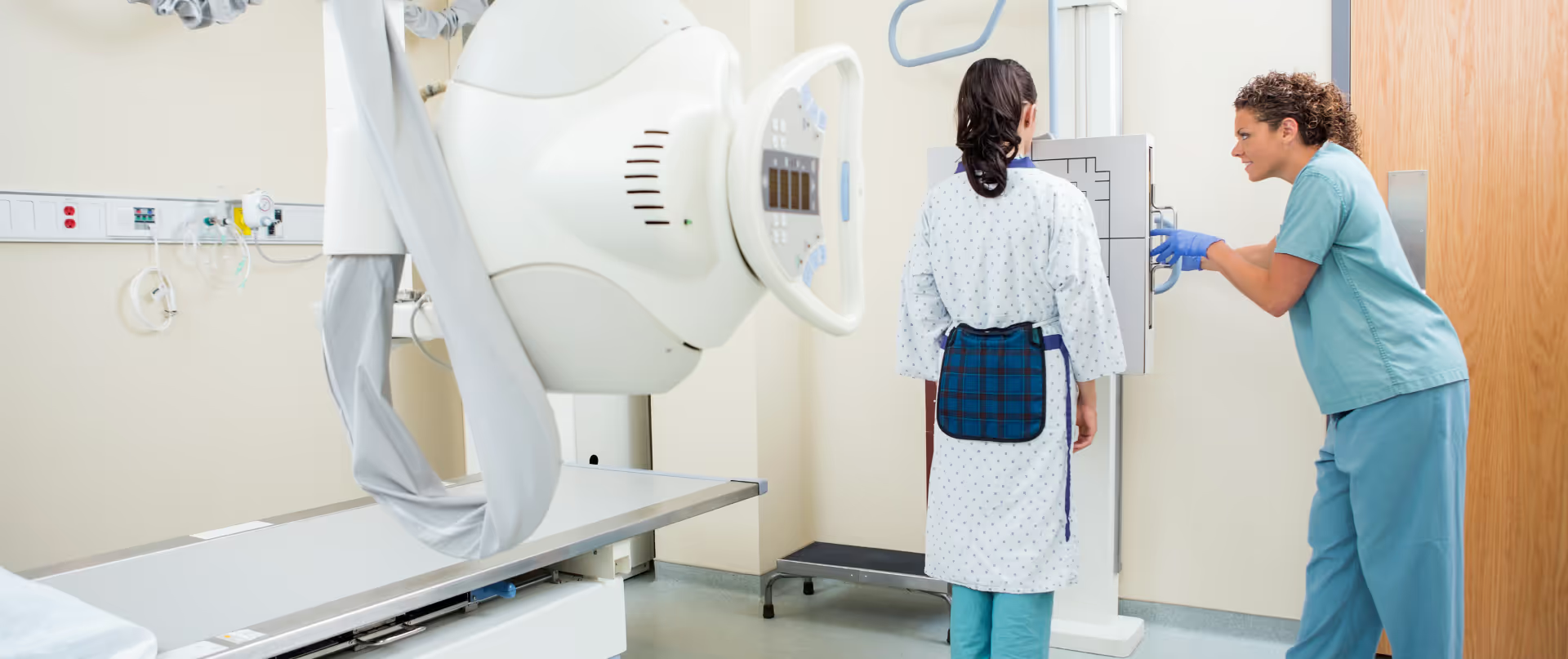Medical imaging technology continues to be one of healthcare's most rewarding career paths, offering competitive salaries, job security, and meaningful patient impact. The average annual salary of Nuclear Medicine Technologist in the United States is $97,580, with specialized positions commanding even higher wages according to current 2024-2025 data.
This comprehensive guide explores the highest paying radiology tech jobs available today, providing healthcare professionals with essential salary data, specialization requirements, and career advancement strategies to maximize earning potential. All salary data is based on the most recent available sources including 2023-2024 BLS data, industry surveys, and current job market analysis.
What Makes Radiology Tech Jobs High-Paying?
High-paying radiology positions share several common characteristics that distinguish them from entry-level roles:
Specialized Training Requirements: The most lucrative positions require additional certifications beyond basic radiologic technology training. Radiographers can earn specialty certificates to increase opportunities for advancement such as in mammography, magnetic resonance imaging (MRI), computed tomography (CT), or interventional radiology.
Advanced Technical Skills: Higher-paying roles demand expertise in complex imaging equipment, radiation safety protocols, and specialized procedures that require extensive knowledge and precision.
Critical Care Applications: Positions supporting emergency departments, intensive care units, and interventional procedures often offer premium compensation due to their urgent nature and specialized requirements.
Top 9 Highest Paying Radiology Tech Jobs
1. Nuclear Medicine Technologist
Salary Range: $83,168 to $118,404 annually (average $97,580)
Nuclear medicine technologists experienced the largest average compensation gains, according to the 2024 ASRT Wage and Salary Survey. These professionals prepare and administer radiopharmaceuticals, operate sophisticated imaging equipment, and work with both adult and pediatric patients across general, cardiac, and oncologic procedures.
Key Responsibilities:
- Administering radioactive tracers to patients
- Operating specialized cameras and computers for diagnostic imaging
- Ensuring radiation safety compliance
- Collaborating with radiologists and cardiologists
Certification Requirements: NMTCB or ARRT certification in nuclear medicine
2. Interventional Radiological Technologist
Salary Range: $66,000 - $129,000+ annually (average varies by region)
Interventional radiology technologists support minimally invasive procedures using advanced imaging guidance. Current market data shows significant salary increases in this specialty, with experienced professionals in metropolitan areas earning well above the national average.
Key Procedures:
- Angioplasty and stent placement
- Embolization procedures
- Image-guided biopsies
- Abscess drainage procedures
Required Skills: Sterile technique proficiency, multiple imaging modality expertise, emergency response capabilities
3. Diagnostic Medical Sonographer (Ultrasound)
Salary Range: $52,000 - $104,000 annually
Ultrasound technologists use sound wave technology to create detailed internal body images. Specialized areas like diagnostic neurosonography, breast ultrasound, and vascular ultrasound command premium salaries, particularly in outpatient settings.
Specialization Areas:
- Cardiovascular sonography
- Breast imaging
- Vascular diagnostics
- Neurosonography
4. Cardiovascular Technologist
Salary Range: $46,000 - $103,000 annually
Working in cardiac catheterization laboratories, cardiovascular technologists assist physicians with complex cardiac and vascular imaging procedures. Outpatient centers and diagnostic laboratories typically offer the highest compensation in this specialty.
5. MRI Technologist
Salary Range: $50,000 - $94,000 annually
MRI technologists work in an environment that challenges them with a wide variety of advanced imaging exams, including cardiac imaging, functional brain imaging, and breast imaging. These positions require extensive knowledge of magnetic resonance physics, cross-sectional anatomy, and IV contrast administration.
Advanced Imaging Types:
- Functional brain imaging
- Cardiac MRI
- Breast MRI
- Musculoskeletal imaging
6. PET Technologist
Salary Range: $46,000 - $91,000 annually
Positron Emission Tomography (PET) technologists specialize in nuclear medicine procedures that reveal metabolic activity within organs and tissues. The complexity of tracer administration and image interpretation drives competitive compensation.
7. Vascular Technologist
Salary Range: $49,000 - $89,000 annually
Given increasing cardiovascular disease rates, vascular technologists are in high demand. They perform specialized ultrasound examinations to detect arterial blockages, blood clots, and vascular abnormalities.
8. CT Technologist
Salary Range: $47,000 - $89,000 annually
Due to the emergent nature of CT examinations, CT technologists often work in fast-paced environments, must be able to take appropriate action when needed, and be "on call" to go to work on a moment's notice, increasing their base pay significantly.
Specialized Applications:
- Emergency trauma imaging
- CT-guided biopsies
- 3D reconstruction imaging
- Peripheral vascular examinations
9. Mammography Technologist
Salary Range: $41,000 - $87,000 annually
Mammography technologists specialize in breast imaging for cancer screening and diagnosis. This field requires exceptional patient communication skills and technical precision for optimal image quality.
Factors That Impact Radiology Tech Salaries
Geographic Location
Location significantly affects earning potential across all radiology specialties. Urban areas and states with higher costs of living typically offer increased compensation to attract qualified professionals.
Highest Paying States:
- California: Premium wages offset by high living costs
- New York: Competitive metropolitan market rates
- Texas: Strong healthcare infrastructure
- Massachusetts: Academic medical center concentration
Work Setting Variations
Different healthcare environments offer varying compensation levels:
Hospital Systems: Comprehensive benefits, advancement opportunities, emergency pay differentials Outpatient Imaging Centers: Often highest base salaries, specialized procedures Academic Medical Centers: Research opportunities, continuing education benefits Mobile Imaging Services: Travel compensation, flexible scheduling
Education and Certification Impact
Advanced credentials directly correlate with earning potential:
Associate Degree: Entry-level positions ($45,000-$65,000) Bachelor's Degree: Supervisory and specialized roles ($55,000-$85,000)
Multiple Certifications: Premium specialist positions ($70,000-$120,000+)
Career Advancement Strategies for Higher Pay
Pursue Multiple Certifications
Cross-training in multiple modalities increases marketability and earning potential. Popular combinations include:
- CT and MRI dual certification
- Mammography and breast ultrasound
- Vascular and cardiac specializations
Develop Leadership Skills
Management positions offer substantial salary increases. Consider pursuing:
- Chief technologist roles
- Department supervision
- Clinical instruction positions
- Quality assurance leadership
Continuing Education Investment
Stay current with technological advances through:
- Annual continuing education requirements
- Professional conference attendance
- Advanced certification programs
- Manufacturer-specific training
Job Market Outlook for Radiology Technologists
The specialty came in at #77 on the list, which is based on factors such as growth potential, work-life balance, job safety, employment rate and salary. The Bureau of Labor Statistics projects steady growth in medical imaging careers through 2033, driven by an aging population and technological advances.
Growth Factors:
- Increased diagnostic imaging utilization
- Technological advancement requiring specialized skills
- Aging population demographics
- Expansion of outpatient imaging services
How to Land High-Paying Radiology Tech Jobs
Build a Competitive Resume
Highlight specialized certifications, continuing education, and clinical experience. Quantify achievements wherever possible, such as patient volume handled or quality metrics achieved.
Network Within the Industry
Professional organizations provide valuable networking opportunities:
- American Society of Radiologic Technologists (ASRT)
- American Registry of Radiologic Technologists (ARRT)
- Specialty-specific organizations (SNMMI, SIIM, ACR)
Consider Travel Assignments
Travel radiology positions often offer premium pay rates, housing allowances, and assignment variety. This can be an excellent way to gain diverse experience while maximizing income.
Frequently Asked Questions
What is the highest paying radiology tech specialization?
Nuclear medicine technologists typically earn the highest salaries, with top positions reaching $124,000 annually. Interventional radiology and specialized sonography also offer exceptional earning potential.
How much does location affect radiology tech salaries?
Geographic location can impact salaries by 30-50%. Urban areas and states like California, New York, and Massachusetts typically offer 20-40% higher wages than rural or lower cost-of-living areas.
Do radiology techs need a bachelor's degree for high-paying jobs?
While an associate degree meets minimum requirements, a bachelor's degree opens doors to supervisory roles, specialized positions, and premium compensation. Many high-paying positions prefer or require bachelor's-level education.
How long does it take to specialize in high-paying radiology areas?
Most specializations require 6-24 months of additional training beyond basic radiologic technology education. Nuclear medicine and interventional radiology typically require the longest specialization periods.
Which certifications offer the best return on investment?
MRI, CT, and mammography certifications offer strong ROI with relatively short training periods. Nuclear medicine and interventional radiology provide the highest earning potential but require more extensive training.
Do radiology techs work nights and weekends?
Many high-paying positions, especially in hospitals, require shift work including nights, weekends, and on-call coverage. Emergency and trauma imaging often commands premium pay for off-hours work.
What soft skills are important for high-paying radiology jobs?
Communication skills, patient care abilities, technical problem-solving, and teamwork are essential. Leadership skills become crucial for advancement to supervisory and management positions.
Conclusion
High-paying radiology tech jobs offer excellent career prospects for healthcare professionals willing to invest in specialized training and certification. With salaries ranging from $87,000 to $124,000 for top specializations, these positions provide both financial security and meaningful patient care opportunities.
Success in maximizing earning potential requires strategic career planning, continuous education, and specialization in high-demand areas like nuclear medicine, interventional radiology, and advanced imaging modalities. Geographic flexibility and willingness to pursue multiple certifications can significantly accelerate career advancement and salary growth.
The medical imaging field continues evolving with technological advances, creating new opportunities for skilled professionals. By staying current with industry trends and maintaining multiple certifications, radiology technologists can build rewarding careers with exceptional earning potential.
Ready to advance your radiology career?
DirectShifts connects healthcare professionals with premium radiology positions nationwide. Our platform specializes in matching qualified technologists with high-paying opportunities across all imaging specializations. Explore available positions today and take the next step toward maximizing your earning potential in medical imaging.
Take the next step in your career! Join DirectShifts to connect with employers seeking allied health professionals like you. Sign up now to explore exciting opportunities!
Sign Up













